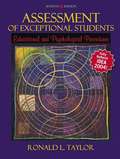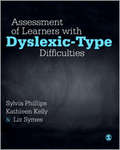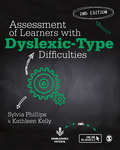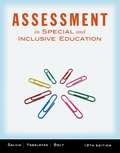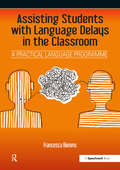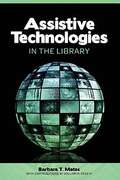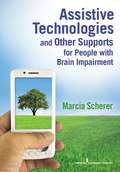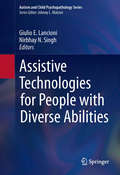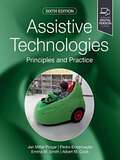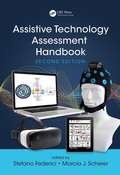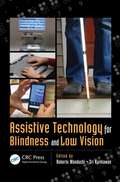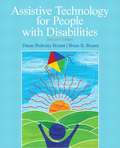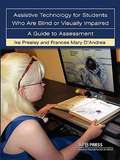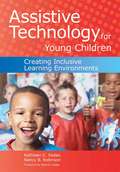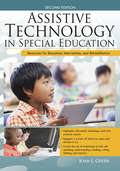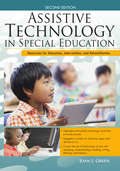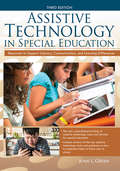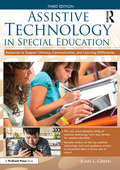- Table View
- List View
Assessment of Children: Cognitive Foundations
by Jerome M. SattlerSection I. Foundations: Challenges in assessing children : the process ; Challenges in assessing children ; Ethical, legal and professional issues ; A primer on statistics and psychometrics ; Ethnic minority children ; Administering tests to children -- Section II. Theories and issues in intelligence: Historical survey and theories of intelligence ; The development and measurement of intelligence -- Section III. The Wechsler tests: Wechsler Intelligence Scale for Children-Fourth edition (WISC-IV) : description ; WISC-IV subtests ; Interpreting the WISC-IV ; Wechsler Preschool and Primary Scale of Intelligence-Third edition (WPPSI-III) : description ; WPPSI-III subtests and interpreting the WPPSI-III ; Wechsler Adult Intelligence Scale-Third edition (WAIS-III) : description ; WAIS-III subtests and interpreting the WAIS-III -- Section IV. Other measures of intelligence: Stanford-Binet Intelligence Scales-Fifth edition (SB5) ; Differential Ability Scales-Second edition (DAS-II) ; Assessment of Intelligence with Specialized Measures -- Section V. Report writing: Report writing
Assessment of Exceptional Students: Educational and Psychological Procedures (7th edition)
by Ronald L. TaylorThis update of the 2003 text treats the role of assessment in recent US laws (e.g., the Individuals with Disabilities Education Act-- IDEA 2004, No Child Left Behind Act) and new/revised tests. In introducing practical and ethical assessment issues, Taylor (Florida Atlantic U.) traces historical events, philosophical movements, legislation, and legal cases involving assessment. He proposes a model comprised of pre- and post-referral components that meet many states' requirements, and presents vignettes for discussion. Appendices include descriptions of instruments used for measuring processing skills, traumatic brain injury, specific target behaviors, and cognitive aspects of special populations. Previous editions appeared between 1984 and 2000. Annotation ©2005 Book News, Inc., Portland, OR (booknews.com)
Assessment of Learners with Dyslexic-Type Difficulties
by Dr Kathleen S. Kelly Liz Symes Sylvia PhillipsThis comprehensive guide enables teachers to understand a range of approaches to the assessment of children with dyslexic-type difficulties. Linking theory, research and practice, practitioners will gain critical knowledge of procedures to analyse, interpret and use in appropriate assessments which will facilitate setting targets for teaching. The book covers: - how to use both informal and formal assessment procedures - frameworks for evaluating published and teacher-made assessments - the professional development needs of any teacher involved in assessment Ideal for those training to be specialist teachers of learners with dyslexia, this text is equally useful to all teachers and SENCOS (Special Educational Needs Co-ordinators) and complements the authors' book Teaching Literacy to Learners with Dyslexia to provide comprehensive guidance for assessing and teaching learners with dyslexic-type difficulties. Sylvia Phillips is an experienced Special Educational Needs educator, and currently leads Glyndwr University's specialist course for teachers of learners with dyslexia. Kath Kelly is Programme Leader for the Masters in Specific Learning Difficulties, Manchester Metropolitan University. Liz Symes is Senior Lecturer in SEN (Special Educational Needs) and Professional Studies, Manchester Metropolitan University.
Assessment of Learners with Dyslexic-Type Difficulties
by Dr Kathleen S. Kelly Sylvia PhillipsReinforcing best practice techniques, the second edition of this specialist guide for the assessment of learners with dyslexic-type difficulties includes: - a new chapter on The Implications of Co-existing Specific Learning Difficulties - updates to legislation including the SEND Code of Practice - updates to specific diagnostic tests - examples of interpreting test profiles - photocopiable resources available to download from the website This comprehensive guide enables teachers to understand a range of approaches to the assessment of children with dyslexic-type difficulties. It is an essential companion for those training to be specialist teachers of learners with dyslexia and a useful resource for all SENCOs, and teachers new or experienced.
Assessment of Learners with Dyslexic-Type Difficulties
by Dr Kathleen S. Kelly Sylvia PhillipsReinforcing best practice techniques, the second edition of this specialist guide for the assessment of learners with dyslexic-type difficulties includes: - a new chapter on The Implications of Co-existing Specific Learning Difficulties - updates to legislation including the SEND Code of Practice - updates to specific diagnostic tests - examples of interpreting test profiles - photocopiable resources available to download from the website This comprehensive guide enables teachers to understand a range of approaches to the assessment of children with dyslexic-type difficulties. It is an essential companion for those training to be specialist teachers of learners with dyslexia and a useful resource for all SENCOs, and teachers new or experienced.
Assessment of Young Children with Special Needs: A Context-Based Approach
by Susan M. Benner Joan GrimAssessment of Young Children with Special Needs, Second Edition helps prepare teachers for the task of evaluating the skills of infants, toddlers, and preschool children with developmental delays and those considered at risk to experience developmental delays or difficulties. A child's environment is a critical consideration when focusing on assessment, and authors Susan Benner and Joan Grim explore the important issues of family resources, health, multidimensional environmental influences, economic deprivation, and domestic violence on infant and child development. This textbook conveys a sense of respect for parents, the powerful influence assessment results can and do have in the lives of young children with special needs, and an understanding of the complexity of child development, progression, and measurement. This book sets the tone for important values and beliefs to honor throughout one's professional life. This fully revised edition addresses recent legislation, updated versions of assessment, and the newest assessment tools that teachers will come across. The popular full-length case studies of the first edition have been updated, and vignettes of other cases are fully integrated across chapters, bringing the text alive with meaning. Assessment of Young Children with Special Needs, Second Edition now includes expanded discussion on progress monitoring and response to intervention, functional behavioral analysis, pros and cons of norm-referenced testing, web-based gathering tools, ELL students, and screening for autism.
Assessment: In Special and Inclusive Education (Twelfth Edition)
by John Salvia James Ysseldyke Sara BoltAssessment is a process of collecting information for the purpose of making important decisions about students. It is critical that those decisions be made both appropriately and fairly. Noted as the standard for professional resources in the field, ASSESSMENT offers basic assessment information along with a handbook-style reference of frank, comprehensive reviews of the tests most administered in K-12 schools. Featuring an emphasis on improved outcomes, the book equips teachers with the tools and knowledge to do assessments correctly as well as use assessment information to bolster student competence.
Assistance Dog Providers in the United States: A Complete Guide to Finding a Guide, Hearing, or Service Dog
by Carla Stiverson Norm PritchettThis book offers excellent information of guide, service and hearing alert dogs and schools and organizations that train them in the United States. offers information on obtaining a working dog, what the different tasks that the dog do, and gives a list of addresses and contacts.
Assisting Students with Language Delays in the Classroom: A Practical Language Programme
by Francesca Bierens'Assisting Students with Language Delays in the Classroom' is a structured language programme designed for teachers and SENCOs to use in the classroom with children and adolescents with a range of language abilities. This resource caters to the needs of a broad range of students who require assistance with their language development, from the pre-verbal skills of language, progressing through to the skills required for effective, interactive conversation. The resource is accordingly structured within three key sections: the Pre-Verbal Skills of Language; the Building Bricks of Language; and the Skills of Conversation. Features: step-by-step instructions; language charts 200+ activities and exercise. Francesca Bierens is a Qualified Speech and Language Therapist and Primary School Teacher with over 33 years experience working with children with speech and language delays and/or disorders, in the Education, Health and Private sectors.
Assistive Technologies In The Library
by Barbara T. Mates William R. Reed IvThis sensitively written and practical guidebook will be an indispensable resource for ensuring that a library’s offerings are accessible to everyone.
Assistive Technologies and Other Supports for People With Brain Impairment
by Marcia J. SchererAssistive Technologies and Other Support for People with Brain Impairment, by Marcia J. Scherer, is a must-have text for academic instructors and their students. The author's synopsis of brain impairment, current rehabilitation strategies, available assistive technologies and resources, as well as the practical merging of the above, makes this an invaluable addition to any academic program in cognitive rehabilitation. This book gives a clear and detailed overview of how the brain reacts to impairment and gives illustrated examples of effective integration of AT into the lives of people with cognitive disability. Integrating current research with the experiences of people with cognitive disabilities, this volume examines how assistive and cognitive support technologies are being harnessed to provide assistance for thinking, remembering, and learning. The book vividly describes real-life situations in which cognitively impaired individuals use assistive supports and the advantages and limitations these individuals perceive from their use. It provides information on how cognitively impaired individuals and their families and caregivers can select the most appropriate technologies from a wide array of accommodations and resources, including individualized protocols of different forms of support to facilitate optimal functioning. The text offers practitioners a comprehensive and systematic process for ensuring their clients' effective application and utilization of this technology. This book will also provide insight for users of assistive technology and their families and caregivers to ensure optimal technology use.
Assistive Technologies for People with Diverse Abilities (Autism and Child Psychopathology Series)
by Nirbhay N. Singh Giulio E. LancioniThe familiar image of the disabled tends to emphasize their limitations and reduced quality of life. However, many people with cognitive, motor, and other difficulties also have the capacity to enhance their social interactions, leisure pursuits and daily activities with the aid of assistive technology. Assistive devices from the simple to the sophisticated, have become essential to intervention programs for this population. And not surprisingly the numbers of devices available are growing steadily. Assistive Technologies for People with Diverse Abilities offers expert analysis of pertinent issues coupled with practical discussion of solutions for effective support. Its comprehensive literature review describes current and emerging devices and presents evidence-based guidelines for matching promising technologies to individuals. Program outcomes are assessed, as are their potential impact on the future of the field. In addition, chapters provide detailed descriptions of the personal and social needs of the widest range of individuals with congenital and acquired conditions, including: Acquired brain damage. Communication impairment. Attention and learning difficulties (with special focus on college students). Visual impairment and blindness. Autism spectrum disorders. Behavioral and occupational disorders. Alzheimer's disease. Severe, profound and multiple impairments. The scope and depth of coverage makes Assistive Technologies for People with Diverse Abilities an invaluable resource for researchers, professionals and graduate students in developmental psychology, rehabilitation medicine, educational technology, occupational therapy, speech pathology and clinical psychology.
Assistive Technologies: Principles and Practice
by Emma Smith Albert M. Cook Janice Miller Polgar Pedro EncarnaçãoMaster the assistive strategies you need to make confident clinical decisions and help improve the quality of life for people with disabilities. Based on the Human Activity Assistive Technology (HAAT) model developed by Albert Cook, Sue Hussey, and Janice Polgar, Assistive Technologies: Principles and Practice, 6th Edition, provides detailed coverage of the broad range of devices, services, and practices that comprise assistive technology. This text offers a systematic process for ensuring the effective application of assistive technologies — and focuses on the relationship between the human user and the assisted activity within specific contexts. New to this edition is updated and expanded content on autonomous features of wheelchairs and vehicles, electronic aids to daily living, robotics, sustainability issues related to assistive technology, and much more.
Assistive Technology Assessment Handbook (Rehabilitation Science In Practice Series)
by Marcia Scherer Stefano FedericiAssistive Technology Assessment Handbook, Second Edition, proposes an international ideal model for the assistive technology assessment process, outlining how this model can be applied in practice to re-conceptualize the phases of an assistive technology delivery system according to the biopsychosocial model of disability. <P><P>The model provides reference guidelines for evidence-based practice, guiding both public and private centers that wish to compare, evaluate, and improve their ability to match a person with the correct technology model. This second edition also offers a contribution to the Global Cooperation on Assistive Technology (GATE) initiative, whose activities are strongly focused on the assistive products service delivery model. <P><P>Organized into three parts, the handbook: gives readers a toolkit for performing assessments; describes the roles of the assessment team members, among them the new profession of psychotechnologist; and reviews technologies for rehabilitation and independent living, including brain–computer interfaces, exoskeletons, and technologies for music therapy. <P><P>Edited by Stefano Federici and Marcia J. Scherer, this cross-cultural handbook includes contributions from leading experts across five continents, offering a framework for future practice and research.
Assistive Technology For Blindness And Low Vision (Rehabilitation Science In Practice)
by Roberto Manduchi Sri KurniawanAssistive technology has made it feasible for individuals with a wide range of impairments to engage in many activities, such as education and employment, in ways not previously possible. The key factor is to create consumer-driven technologies that solve the problems by addressing the needs of persons with visual impairments. Assistive Technology for Blindness and Low Vision explores a broad range of technologies that are improving the lives of these individuals. Presenting the current state of the art, this book emphasizes what can be learned from past successful products, as well as what exciting new solutions the future holds. <P><P> Written by world-class leaders in their field, the chapters cover the physiological bases of vision loss and the fundamentals of orientation, mobility, and information access for blind and low vision individuals. They discuss technology for multiple applications (mobility, wayfinding, information access, education, work, entertainment), including both established technology and cutting-edge research. The book also examines computer and digital media access and the scientific basis for the theory and practice of sensory substitution. <P><P> This volume provides a holistic view of the elements to consider when designing assistive technology for persons with visual impairment, keeping in mind the need for a user-driven approach to successfully design products that are easy to use, well priced, and fill a specific need. Written for a broad audience, this book provides a comprehensive overview and in-depth descriptions of current technology for designers, engineers, practitioners, rehabilitation professionals, and all readers interested in the challenges and promises of creating successful assistive technology.
Assistive Technology For Children And Youth With Disabilities
by Mary Ann Marchel Denise M. Clark Thomas A. FischerEncompassing home, school and community environments, Assistive Technology for Children and Youth with Disabilities highlights the vast amount of supports available for children with disabilities from birth to age 21. An informative resource, the text details not only what types of assistive technology exist, but also how to select technology to meet specific students needs and match specific environmental circumstances. Chapters address the broad range of technologies now available, including supports for mobility, positioning, access, academic areas, behavior problems, recreation, and transitioning. Case examples, vignettes and activities provide practical, real-life examples that show how to use assistive technology to improve the independence and participation of students with special needs.
Assistive Technology For People With Disabilities (Second Edition)
by Diane Pedrotty Bryant Brian R. BryantAssistive Technology for People with Disabilities, Second Edition, includes eight comprehensive chapters that focus on devices and software to enhance the lives and promote the independence of people with disabilities. Updated with new research, content and features to address current developments in the field, the book approaches assistive technology and education in a lifespan, multidisciplinary manner by discussing the use of current technology in the fields of special education, rehabilitation, speech-language pathology, and other disciplines. Featured devices and software will help you understand how areas such as mobility, communication, education, independent living, and access to information media affect learning and living for individuals with disabilities. You will also gain a great understanding of the foundational and historical perspectives of AT, assessment, universal design, and the ADAPT framework, which is a tool to help educators make decisions about appropriate AT, student needs, and the demands of the environment. Developed from the authors' years of experience teaching both K-12 students and adults, as well as their own framework for understanding assistive technology application and integrating technology into instruction, this new edition addresses assistive technology that promotes knowledge and skills, practical application and a myriad of opportunities that good technology provides for persons with disabilities.
Assistive Technology For Students Who Are Blind or Visually Impaired: A Guide to Assessment
by Frances Mary D'Andrea Ike PresleyAssistive technology is essential in todays world to enable people who are blind or visually impaired to participate fully in school, work, and life. But which assistive technology tools are right for your students? This comprehensive handbook is the essential resource for teachers of students with visual impairments, administrators, technology professionals, and anyone who needs to keep up with the ever-changing world of technology. Assistive Technology For Students Who Are Blind or Visually Impaired: A Guide to Assessment contains a wealth of technical information translated into clear, user-friendly terms, including: An overview of the full range of assistive technology that students can use to manage information in print or electronic formats-whether they use vision, touch or hearing to access information How to select appropriate tools and strategies A structured process for conducting a technology assessment Detailed assessment forms that can be used to determine students technology needs and solutions to address them Advice on writing up program recommendations based on assessment results Reproducible, blank assessment forms
Assistive Technology For Young Children: Creating Inclusive Learning Environments
by Kathleen Curry Sadao Nancy B. RobinsonThis book appeals to the needs of a wide range of readers who seek to increase their technology competencies in order to improve access to learning for children with disabilities.
Assistive Technology In Special Education: Resources for Education, Intervention, and Rehabilitation (Second Edition)
by Joan GreenFamilies, teachers, and therapists who are searching for an update about how to use the latest technologies to help individuals who struggle with communication, literacy, and learning will benefit from the wealth of practical, well-organized information in this second edition of Assistive Technology in Special Education. The indexed update presents an overview of the uses of technologies to help readers zero in on specific, powerful, cutting-edge resources they can use to enhance success. The book features new tools to improve and compensate for challenges relating to speaking, understanding, reading, writing, thinking and remembering, as well as strategies to help students become more organized and efficient. The use of tablets such as the iPad and smartphones, as well as cloud-based products, are highlighted. Online resources and social networking tools are presented to empower readers to learn about new products as they become available.
Assistive Technology Solutions in Minutes, Book 2: Ordinary Items, Extraordinary Solutions
by Therese WillkommAssistive technology "MacGyver" Therese Willkomm, Ph.D., returns with her second book of five-minute, low-cost approaches for taking ordinary items and turning them into extraordinary solutions for individuals with disabilities. Picking up where the first book left off, AT Solutions in Minutes II demonstrates creative DIY problem solving without the need for power tools or electricity, empowering everyone to be spontaneous and create solutions to everyday challenges using everyday materials. T Every solution can be made using simple and readily-available tools like a utility knife, pliers, scissors, a wire stripper, and a mini blowtorch, among others. Thanks to a grant from the Gibney Foundation, one hundred percent of the proceeds from this book will fund assistive technology devices for New Hampshire's device loan and demonstrations provided through ATinNH, New Hampshire's assistive technology program at the University of New Hampshire's Institute on Disability.
Assistive Technology in Special Education: Resources for Education, Intervention, and Rehabilitation
by Joan GreenFamilies, teachers, and therapists who are searching for an update about how to use the latest technologies to help individuals who struggle with communication, literacy, and learning will benefit from the wealth of practical, well-organized information in this second edition of Assistive Technology in Special Education. The indexed update presents an overview of the uses of technologies to help readers zero in on specific, powerful, cutting-edge resources they can use to enhance success. The book features new tools to improve and compensate for challenges relating to speaking, understanding, reading, writing, thinking and remembering, as well as strategies to help students become more organized and efficient. The use of tablets such as the iPad and smartphones, as well as cloud-based products, are highlighted. Online resources and social networking tools are presented to empower readers to learn about new products as they become available.
Assistive Technology in Special Education: Resources to Support Literacy, Communication, and Learning Differences
by Joan GreenAssistive Technology in Special Education presents a wealth of practical, well-organized information to help families, teachers, and therapists find effective solutions for students with learning, literacy, and cognitive challenges. This third edition features new affordable tools to improve and compensate for challenges related to speaking, understanding, reading, writing, and thinking and remembering, as well as strategies to help students become more organized and efficient. Also highlighted are iDevices, G Suite (Google Apps and Extensions), online collaborative sites, and features built into the computers and mobile devices readers already use. As technology changes and new operating systems make older programs obsolete, this book will empower readers to explore the most current resources as they become available.
Assistive Technology in Special Education: Resources to Support Literacy, Communication, and Learning Differences
by Joan L. GreenAssistive Technology in Special Education presents a wealth of practical, well-organized information to help families, teachers, and therapists find effective solutions for students with learning, literacy, and cognitive challenges. This third edition features new affordable tools to improve and compensate for challenges related to speaking, understanding, reading, writing, and thinking and remembering, as well as strategies to help students become more organized and efficient. Also highlighted are iOS devices, G Suite (Google Apps and Extensions), online collaborative sites, and features built into the computers and mobile devices readers already use. As technology changes and new operating systems make older programs obsolete, this book will empower readers to explore the most current resources as they become available.
Assistive Technology in the Classroom
by Amy G. Dell Deborah A. Newton Jerry G. PetroffWith an emphasis on the integration of assistive technology into the curriculum, this text focuses on how assistive technology can be used in schools to enhance the teaching and learning of students with disabilities.

